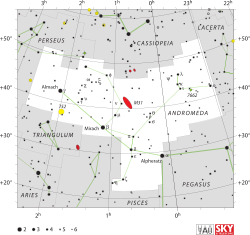Binary star system in the constellation Andromeda
π Andromedae in optical light Pi Andromedae (Pi And , π Andromedae , π And ) is the Bayer designation for a binary star [ 3] constellation of Andromeda . With an apparent visual magnitude of 4.4,[ 2] visible to the naked eye . It is located approximately 580 light-years (180 parsecs ) from Earth .[ 1]
The pair is classified as a blue-white B-type main sequence dwarf , with an apparent magnitude of +4.34. It is a spectroscopic binary with an orbital period of 143.6 days and an eccentricity of 0.56. [ 3]
The spectroscopic binary forms a triple system with BD+32 102 , a magnitude 8.6 star located 35.9 arcseconds away.[ 3] arcseconds separation is an 11th magnitude companion that is just located on the same line of sight, but at a very different distance from us.
Naming
In Chinese , 奎宿 Kuí Sù Legs (asterism)η Andromedae , 65 Piscium , ζ Andromedae , ε Andromedae , δ Andromedae , ν Andromedae , μ Andromedae , β Andromedae , σ Piscium , τ Piscium , 91 Piscium , υ Piscium , φ Piscium , χ Piscium and ψ¹ Piscium . Consequently, the Chinese name for π Andromedae itself is 奎宿六 Kuí Sù liù the Sixth Star of Legs .)[ 8]
References
^ a b c d e f Brown, A. G. A. ; et al. (Gaia collaboration) (2021). "Gaia Early Data Release 3: Summary of the contents and survey properties" . Astronomy & Astrophysics 649 : A1. arXiv :2012.01533 Bibcode :2021A&A...649A...1G . doi :10.1051/0004-6361/202039657 S2CID 227254300 . (Erratum: doi :10.1051/0004-6361/202039657e ) . Gaia EDR3 record for this source at VizieR .^ a b c d Johnson, H. L.; et al. (1966), "UBVRIJKL photometry of the bright stars", Communications of the Lunar and Planetary Laboratory , 4 (99): 99, Bibcode :1966CoLPL...4...99J . ^ a b c d e f Eggleton, P. P.; Tokovinin, A. A. (September 2008). "A catalogue of multiplicity among bright stellar systems" . Monthly Notices of the Royal Astronomical Society . 389 (2): 869– 879. arXiv :0806.2878 Bibcode :2008MNRAS.389..869E . doi :10.1111/j.1365-2966.2008.13596.x S2CID 14878976 . ^ a b c d Cenarro, A. J.; et al. (January 2007), "Medium-resolution Isaac Newton Telescope library of empirical spectra - II. The stellar atmospheric parameters", Monthly Notices of the Royal Astronomical Society 374 (2): 664– 690, arXiv :astro-ph/0611618 Bibcode :2007MNRAS.374..664C , doi :10.1111/j.1365-2966.2006.11196.x S2CID 119428437 . ^ Wilson, Ralph Elmer (1953), "General Catalogue of Stellar Radial Velocities", Carnegie Institute Washington D.C. Publication , Washington: Carnegie Institution of Washington, Bibcode :1953GCRV..C......0W . ^ Anderson, E.; Francis, Ch. (2012), "XHIP: An extended hipparcos compilation", Astronomy Letters , 38 (5): 331, arXiv :1108.4971 Bibcode :2012AstL...38..331A , doi :10.1134/S1063773712050015 , S2CID 119257644 . ^ Abt, Helmut A.; Levato, Hugo; Grosso, Monica (July 2002), "Rotational Velocities of B Stars", The Astrophysical Journal , 573 (1): 359– 365, Bibcode :2002ApJ...573..359A , doi :10.1086/340590 ^ (in Chinese) AEEA (Activities of Exhibition and Education in Astronomy) 天文教育資訊網 2006 年 5 月 19 日 Archived 2016-03-03 at the Wayback Machine
External links

